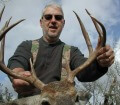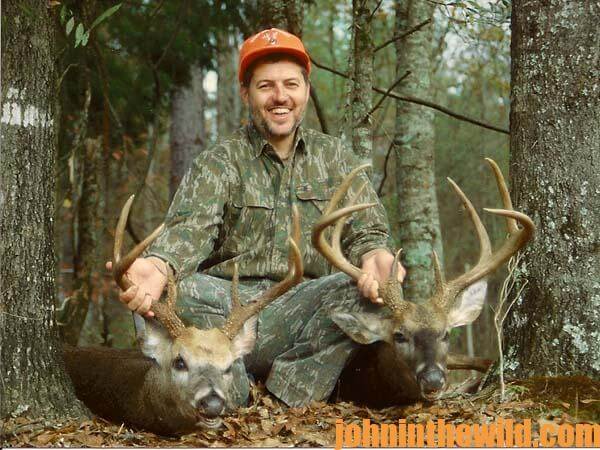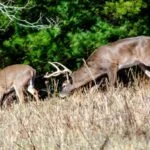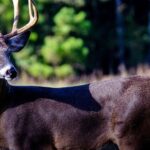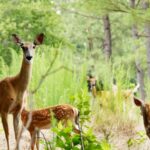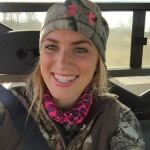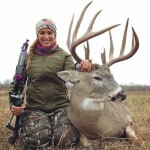John’s Note: To bag a very big buck this season with a short shot, learn to hunt places no one else will hunt. Look for buck signs where you only may see 20 to 50 yards. Instead of hunting sites where you can shoot to the maximum range of your slug gun, hunt spots where you’ll get a short shot at a big buck.
 For many years, competitive bass fishermen have known they have the greatest odds for catching bass if they can shrink the lake areas where they fish. They concentrate on fishing the spots where they most likely can catch big bass.
For many years, competitive bass fishermen have known they have the greatest odds for catching bass if they can shrink the lake areas where they fish. They concentrate on fishing the spots where they most likely can catch big bass.
If you learn to decrease the amount of woods you hunt like the pro fishermen shrink their water, you either can take a shot at any buck or get a short shot at a big buck.
To reduce the size of the woods you hunt to see more deer, eliminate land where deer shouldn’t appear. In most sections of the nation, bucks realize the more they expose themselves in open country, the greater their chances are of having fatal encounters with hunters. Bucks usually avoid open areas. Purchase an aerial photo of the land you hunt. Remove any open regions you see on it from your hunt plan.
Also, if you have hunted a site for many years, mark the spots where most hunters hunt. If you have a new section of public land to hunt, contact the game warden, bowhunting shops and sporting-goods stores close by. Learn the most hunted spots. Once you obtain this information, never hunt these regions. Also you can go to www.mytopomap.com and download maps, as well as information about landowners where you want to hunt.
If you have hunted this land before, mark the spots where you have:
* seen bucks in the past;
* found scrape lines;
* identified food trees and wild foods;
* detected food plots; and
* heard that other hunters already had taken bucks there.
As creatures of habit, bucks tend to use the same scrapes, trails, creek crossings and feeding sites for generations. You’ll have a good opportunity to see bucks in the places where you’ve sighted them in the past. However, most of these locations will remind you of community fishing holes -everyone in town knows he can take a deer there.
Identify Funnels:
Look for funnel areas on your aerial photos where two types of habitats converge next to large woodlots as places to get short shots. You can find such bottlenecks where:
* a creek comes close to a clear-cut with a small neck of woods in-between;
* an agricultural field and a pine plantation corner each other;
* a clear-cut and a pine plantation nearly meet with woods separating them;
* a thicket divides an abandoned strip mine area;
* a hardwood forest or a beaver dam divides flood timber; and
* a highway or railroad tracks separate a strip of woods and an agriculture field.
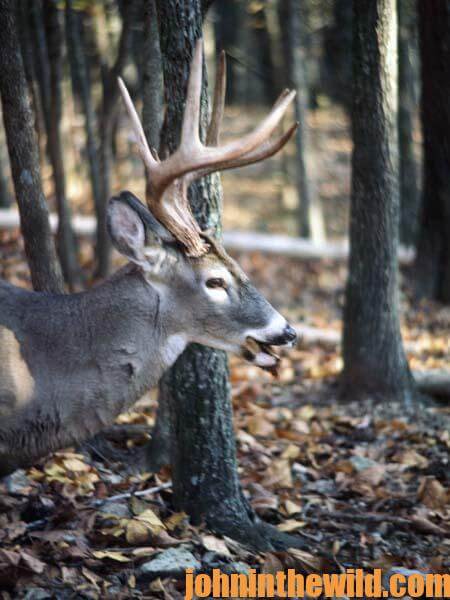 Many of these regions won’t extend past widths of 20 to 50 yards. However, deer will travel between woodlots using these corridors. If you decide to scout these areas, you probably will see little or no deer sign. Deer usually meander through bottlenecks rather than travel along well-defined trails. Deer also rarely leave scrapes in these corridors. Instead, they begin to scrape on either end of these funnels. Because you see little or no sign of deer in bottlenecks, you know other hunters who have scouted the same places also have found no reason to hunt them. You probably will have little or no competition for deer at these short-shot regions. For the best results, erect stands early in the season close to bottlenecks. Make every effort to hide these stands from the sight of other hunters. Only hunt bottlenecks when you have a favorable wind and always approach them from the side. Never walk through or near these high-traffic deer areas.
Many of these regions won’t extend past widths of 20 to 50 yards. However, deer will travel between woodlots using these corridors. If you decide to scout these areas, you probably will see little or no deer sign. Deer usually meander through bottlenecks rather than travel along well-defined trails. Deer also rarely leave scrapes in these corridors. Instead, they begin to scrape on either end of these funnels. Because you see little or no sign of deer in bottlenecks, you know other hunters who have scouted the same places also have found no reason to hunt them. You probably will have little or no competition for deer at these short-shot regions. For the best results, erect stands early in the season close to bottlenecks. Make every effort to hide these stands from the sight of other hunters. Only hunt bottlenecks when you have a favorable wind and always approach them from the side. Never walk through or near these high-traffic deer areas.
According to Dr. Larry Marchinton, a well-known retired wildlife researcher at the University of Georgia, “Funnels often provide the best places in any woodlot to see the most deer. By hunting a funnel area, you have an extremely-good chance of seeing a nice buck, because bucks travel more often than they normally do when they chase estrous does during the rut. Since the does will go back and forth through the funnels, you’ll notice increased buck activity in these regions.”
To learn more about deer hunting, you can get John E. Phillips’ Kindle eBooks, “How to Hunt and Take Big Buck Deer on Small Properties,” (John’s latest book), “How to Hunt Deer Up Close: With Bows, Rifles, Muzzleloaders and Crossbows,” “PhD Whitetails: How to Hunt and Take the Smartest Deer on Any Property,” “How to Take Monster Bucks,” and “How to Hunt Deer Like a Pro,” or to prepare venison, get “Deer & Fixings.” Click here to get these books.
About the Author
John Phillips, winner of the 2012 Homer Circle Fishing Award for outstanding fishing writer by the American Sportfishing Association (ASA) and the Professional Outdoor Media Association (POMA), the 2008 Crossbow Communicator of the year and the 2007 Legendary Communicator chosen for induction into the National Fresh Water Hall of Fame, is a freelance writer (over 6,000 magazine articles for about 100 magazines and several thousand newspaper columns published), magazine editor, photographer for print media as well as industry catalogues (over 25,000 photos published), lecturer, outdoor consultant, marketing consultant, book author and daily internet content provider with an overview of the outdoors. Click here for more information and a list of all the books available from John E. Phillips.

